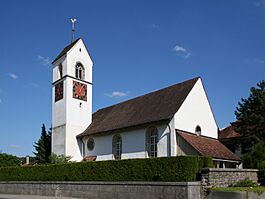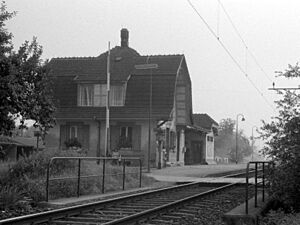Rüti bei Büren facts for kids
Quick facts for kids
Rüti bei Büren
|
||
|---|---|---|

Rüti bei Büren's Reformed Church
|
||
|
||
| Country | Switzerland | |
| Canton | Bern | |
| District | Seeland | |
| Area | ||
| • Total | 6.5 km2 (2.5 sq mi) | |
| Elevation | 437 m (1,434 ft) | |
| Population
(Dec 2020 )
|
||
| • Total | 867 | |
| • Density | 133.4/km2 (345.5/sq mi) | |
| Postal code |
3295
|
|
| Surrounded by | Grenchen, Arch, Bibern, Gossliwil, Oberwil bei Büren and Büren an der Aare | |
Rüti bei Büren is a small town in Switzerland. It is located in the Bern canton, which is like a state in Switzerland. The town is part of the Seeland area. It also has its own church parish, which is part of the Swiss Reformed Church.
Contents
History of Rüti bei Büren
Rüti bei Büren was first written about in 1185. Back then, it was called in litore Ruthi. Later, in 1257, it was known as Ruti prope Burron.
Early Settlements and Roman Times
People lived near Rüti bei Büren a very long time ago. We know this because old neolithic tools have been found. The Neolithic period was a time when people first started farming.
There are also ancient burial mounds from the Hallstatt culture in Rütiwald. These are called tumuli and are like small hills where people were buried.
Later, during the Roman era, there was a large Roman farm at a place called Buchsi. Roman building parts have also been found near the church. A main Roman road that crossed Switzerland also went through the area where Rüti bei Büren is today.
Castles and Rulers
During the Early and High Middle Ages, a castle called Teufelsburg (Devil's Castle) stood above the village in the Rütiwald forest. This castle was very impressive. It had a big outer wall, called a ring wall, with four smaller walls outside it.
This castle might have been the home of important families called the Counts of Buchegg. Later, Rüti belonged to another group of rulers, the Counts of Strassberg. In 1388, the city of Bern took over all their land, including Rüti. In 1393, Rüti became part of a new area called the Büren bailiwick, which was a district ruled by a local official.
The Village Church
The village church is called St. Mauritius. It was first mentioned in records in 1251. The main part of the church, called the nave, was built in a Romanesque style. This style often uses round arches. The back part, called the choir, was built in an early-Gothic style, which often has pointed arches.
The church was made bigger in 1689. In 1911, old paintings on the walls, called murals, were found again and fixed. These paintings were from around 1450.
Modern Development
Even after a train station was built in 1912, Rüti bei Büren stayed a small, quiet village. Until about 1960, most people worked in farming. There were only a few small businesses, like a factory that made wooden items.
Around 1960, things started to change. A chemical plant and a watch factory opened in the village. The watch factory was quite big and employed about 300 people. However, by 1980, the watch industry faced problems, and many people lost their jobs. By the year 2000, most people (over 70%) who worked in Rüti bei Büren traveled to other towns for their jobs. They commuted to places like Büren, Grenchen, Biel, Bern, or Solothurn.
Geography of Rüti bei Büren
Rüti bei Büren covers an area of about 6.5 square kilometers (2.5 square miles). A large part of this land is used for farming, about 49%. Forests cover about 37.8% of the area.
About 9.5% of the land is built up with buildings and roads. A smaller part, 3.5%, is covered by rivers or lakes. Most of the water in the town is from flowing rivers.
The town is located on the right side of the Aare river. It is on the north-western edge of a high area called the Bucheggberg plateau.
In 2010, the old district that Rüti bei Büren belonged to was changed. The town then joined a new administrative area called Verwaltungskreis Seeland.
Town Symbol: Coat of Arms
The coat of arms is like a special symbol for the town. For Rüti bei Büren, it shows a red shield with two silver tools that look like axes, crossed over each other. These tools have gold handles. There are also two silver five-pointed stars on the shield.
People of Rüti bei Büren
Rüti bei Büren has a population of about 800 people. In 2010, about 4.6% of the people living there were from other countries. Over the past 10 years (2000-2010), the number of people living in the town has gone down a bit.
Languages Spoken
Most people in Rüti bei Büren speak German. In 2000, about 94.5% of the people spoke German as their first language. The next most common language was French, spoken by 2% of the people. A small number of people also spoke Albanian or Italian.
Where People Live
In 2008, about 49.2% of the population was male and 50.8% was female. Most people living in Rüti bei Büren were born in Switzerland. About 43% were born right in Rüti bei Büren.
Age Groups
In 2010, children and teenagers (ages 0-19) made up about 19.6% of the population. Adults (ages 20-64) were the largest group, at 61.5%. Seniors (over 64 years old) made up 19% of the population.
Family Life
In 2000, many people in Rüti bei Büren were married (439 people). There were also 354 single people, 60 widows or widowers, and 45 divorced people.
Most homes in the town were permanently lived in. In 2000, about 92.5% of the apartments were always occupied.
Population Changes Over Time
The chart below shows how the population of Rüti bei Büren has changed over many years:

Important Heritage Sites
The entire village of Rüti bei Büren is considered an important heritage site for Switzerland. This means its history and buildings are protected.
Economy and Jobs
Rüti bei Büren has a company that handles chemical waste. In the 1990s, there was a big discussion about whether this company should build a facility to burn dangerous waste. People in the town were against it, so the plan was eventually stopped.
Work and Businesses
In 2011, the unemployment rate in Rüti bei Büren was 2.02%. This means only a small number of people who wanted jobs couldn't find them.
In 2008, there were 455 people working in the town.
- About 47 people worked in the primary sector, which includes farming. There were 18 businesses in this area.
- About 138 people worked in the secondary sector, which includes manufacturing and construction. There were 13 businesses in this area.
- About 270 people worked in the tertiary sector, which includes services like shops, transport, and healthcare. There were 20 businesses in this area.
Many people who live in Rüti bei Büren travel to other towns for work. In 2000, 329 people left the town to work elsewhere, while 156 people came into the town for work. This means more people leave Rüti bei Büren for jobs than come in. Most people (59%) used a private car to get to work, while 13% used public transportation.
Religion in Rüti bei Büren
Based on information from 2000:
- About 10.6% of the people were Roman Catholic.
- About 78.6% belonged to the Swiss Reformed Church.
- A small number of people belonged to other Christian churches, including Orthodox and Christian Catholic.
- About 2.23% of the population was Islamic.
- There was 1 person who was Buddhist.
- About 4.45% of the people said they did not belong to any church, or were agnostic or atheist.
Education in Rüti bei Büren
In Rüti bei Büren, about 40.3% of the people have finished high school (called non-mandatory upper secondary education in Switzerland). About 8% have gone on to higher education, like university or a special college called a Fachhochschule.
School System
The school system in the Canton of Bern works like this:
- One year of optional Kindergarten.
- Six years of Primary school.
- Three years of required lower Secondary school. In this stage, students are grouped based on their abilities.
- After lower Secondary, students can continue their education or start an apprenticeship to learn a trade.
In the 2009-2010 school year, 58 students went to school in Rüti bei Büren. There was one kindergarten class with 13 students. There were three primary classes with 45 students.
In 2000, only one student from another town came to school in Rüti bei Büren. However, 58 students who lived in Rüti bei Büren went to schools outside the town.
Notable People from Rüti bei Büren
- Samuel Schmid (SVP) – He was a very important politician. He was a member of the Swiss Federal Council (like a government minister) from 2000 to 2008. He was also the President of the Swiss Confederation in 2005.
See also
 In Spanish: Rüti bei Büren para niños
In Spanish: Rüti bei Büren para niños







